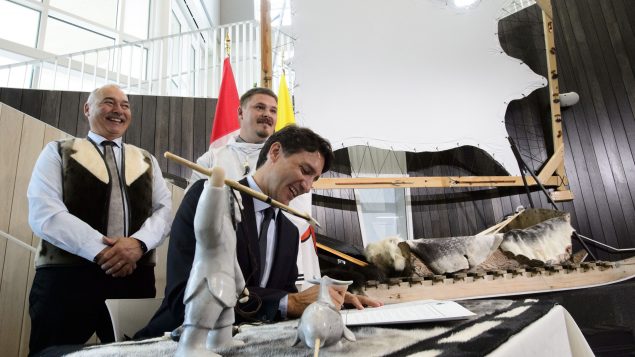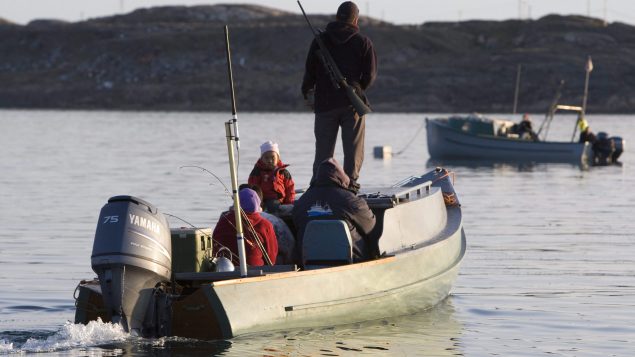The federal government and the Inuit announced Thursday the first step in the creation of a new marine protected area in the northernmost part of Nunavut in the High Canadian Arctic.
The proposed Tuvaijuittuq Marine Protected Area is located off northern Ellesmere Island, covering nearly 320,000 square kilometres of ocean, Prime Minister Justin Trudeau, Nunavut Premier Joe Savikataaq and P.J. Akeeagok, president of the Qikiqtani Inuit Association (QIA), said during a joint announcement in Iqaluit.
They also announced the completion of the long-sought Tallurutiup Imanga National Marine Conservation Area through an Inuit Impact and Benefit Agreement in the northeastern part of the fabled Northwest Passage.
Together, these areas cover more than 427,000 square kilometres, giving the Liberal government bragging rights to say that Canada now protects nearly 14 per cent of its marine and coastal areas, exceeding its own target of protecting 10 per cent of Canada’s marine and coastal areas by 2020.
Canada’s largest marine conservation area

Tallurutiup Imanga National Marine Conservation Area is currently the largest marine protected area in Canada at approximately 109,000 square kilometres. (Pew Charitable Trusts)
The federal government also announced $55 million in funding to establish a joint Crown-Inuit governance model for the Tallurutiup Imanga National Marine Conservation Area, which will protect more than 109,000 square kilometres of biologically rich Arctic waters.
The agreement also creates an Inuit stewardship program managed by QIA), which represents approximately 14,000 Inuit in the Qikiqtani (Baffin) Region of Nunavut, in each of the five hamlets in the area—Grise Fiord, Resolute Bay, Arctic Bay, Pond Inlet, and Clyde River.
- Inuit and Ottawa reach agreement in principle on Arctic marine conservation area
- Environmental group calls for protection of Lancaster Sound
In addition, Ottawa pledged to invest $190 million over seven years for infrastructure projects – the construction of small-craft harbours and a training centre – in the five Inuit communities.
“There is no question the climate crisis is changing the face of the Arctic as we know it. Populations of belugas, narwhals, walruses, seals, polar bears and thousands of other species who depend on year-round sea ice to survive are now migrating, dwindling, or in some cases, disappearing,” said Trudeau.
“For Inuit who have relied on hunting and harvesting to feed their families, climate change imperils their livelihoods and their way of life.”
Culmination of decades of work

Prime Minister Justin Trudeau takes part in a signing ceremony with PJ Akeeagok, president of the Qikiqtani Inuit Association, and Nunavut Premier Joe Savikataaq following an announcement regarding marine conservation and investments in Inuit communities in Iqaluit, Nunavut on Thursday, Aug 1, 2019. (Sean Kilpatrick/THE CANADIAN PRESS)
The announcement also represents the Liberal government’s commitment to reconciliation with Canada’s Indigenous Peoples and Inuit in particular, Trudeau said.
“That is essential and it’s something that goes not just to fighting and mitigating the impacts of climate change, which it’s a big piece of, it goes to not just investments in infrastructure and sovereignty in the North in partnership with Inuit, which is so important,” Trudeau said. “It goes to reaching our global targets on marine protection – surpassing our global targets on marine protection – and it goes to that relationship around reconciliation that matters to Inuit but also matters to non-Indigenous Canadians.”
Akeeagok said Thursday’s “historic” announcement is the culmination of decades of work by visionary Inuit leaders to preserve their waters and sea ice.
“By protecting Tallurutiup Imanga, and seeking permanent protection for Tuvaijuittuq, we not only save these pristine Arctic ecosystems, but also lay the foundation for a conservation economy in sustainable industries such as fisheries,” Akeeagok said.
These investments in jobs and infrastructure will have profound impacts in the High Arctic and serve as a model of what can be achieved when we work as equal partners in the spirit of reconciliation, he added.
Biologically rich area

Inuit hunters go out in their boat as the sun prepares to set in Iqaluit, Nunavut, Friday, August 21, 2009. (Jonathan Hayward/THE CANADIAN PRESS)
Christopher Debicki, vice-president of policy development for conservation group Oceans North, said the Tallurutiup Imanga area is home to large populations of narwhal, bowhead whales, beluga and other marine mammals that migrate through its icy waters each year.
“We are thrilled to celebrate the protection of this spectacular marine ecosystem in a way that will benefit Inuit and all Canadians for future generations,” said Debicki. “This is a sign of Canada’s commitment to conserve its Arctic waters, including other biologically rich regions like the North Water polynya.”
Co-management of this area by Inuit and the federal government speaks to the critical importance of having Inuit involved in governance of their adjacent waters, he added.
“We believe this is a very positive development and hope it is a sign that Canada recognizes the value of joint governance with Inuit in the larger Canadian Arctic marine region,” Debicki said.
‘Where ice never melts’

Ranger Joe Amarualik, from Iqaluit, Nunavut, drives his snowmobile on the ice during a Canadian Ranger sovereignty patrol near Eureka, on Ellesmere Island, Nu., on March 31, 2007. (Jeff McIntosh/THE CANADIAN PRESS)
Tuvaijuittuq, which means the “the place where ice never melts” in Inuktitut, is a unique area due to the presence of multi-year pack ice throughout the year, even in the summer. This type of ice is critically important for Arctic under-ice ecosystems and species.
There is very little human activity in this area, except for a small Canadian military base at Alert, the world’s northernmost permanently inhabited settlement, and weather, communication and research facilities further south in Eureka.
Designating Tuvaijuittuq as a marine protected area will help protect and conserve the important biological diversity, and the unique habitat and ecosystem of this area, officials said. The designation stops any new activity in the area for up to five years while the federal government continues scientific research and extensive consultations with partners, stakeholders, and northern communities, they added.







For reasons beyond our control, and for an undetermined period of time, our comment section is now closed. However, our social networks remain open to your contributions.